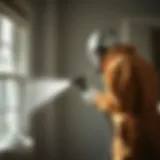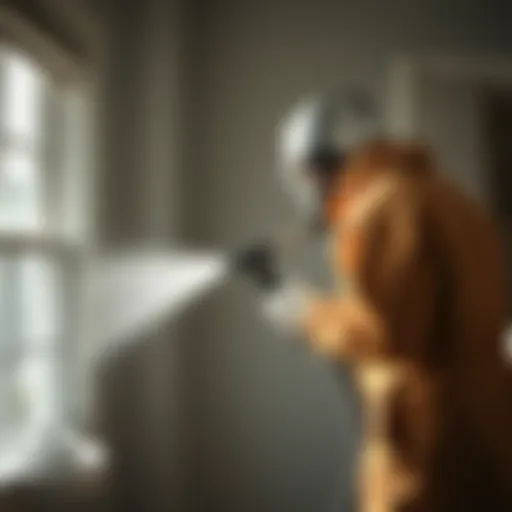Finding the Right Termite Exterminators Near You
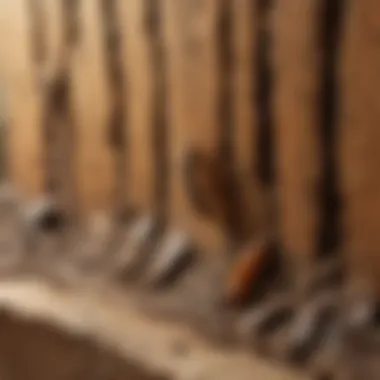

Intro
Termites pose a significant threat to homes and properties. Understanding these pests is fundamental for picking the right exterminator. This guide aims to simplify the process, enabling homeowners to identify effective termite exterminators in their area.
By focusing on termite behavior, their life cycles, and effective prevention and control methods, this guide helps readers navigate their options. Whether you are a cautious homeowner or a pest control professional, acquiring the right tools can ensure effective management of termites.
Understanding the Pest
Identification
Correctly identifying termites is crucial for effective extermination. Termites are often mistaken for ants due to their similar appearance. However, specific characteristics can help distinguish them. For instance, termites have straight antennae and a broad waist, while ants have elbowed antennae and a narrow waist. Recognizing these features can save time and money in the long run.
Life Cycle
Termites have a complex life cycle consisting of several stages: egg, nymph, and adult. The egg stage lasts a few weeks, leading to nymphs that resemble adults but are smaller. Once they grow, they can become workers, soldiers, or reproductive adults. Understanding this cycle is essential; knowing when to treat an infestation can make a significant difference in pest management outcomes.
Pest Prevention Strategies
Environment Modification
Preventing termite infestations can be approached through environment modifications. Simple measures include ensuring proper drainage around the home and removing any wood-to-soil contact. Keeping gardens free from wood debris also minimizes breeding grounds for termites.
Physical Barriers
Physical barriers can prevent termites from gaining access to a home. Installing metal mesh or sand barriers during the construction phase is an effective strategy. Interestingly, these methods can also signal a commitment to long-term pest management.
Control Methods
Chemical Control
Chemical control remains a common method for eliminating termites. Several products, like Termidor and Boric Acid, are effective in managing infestations. It’s crucial to work with a licensed exterminator who can apply these chemicals safely.
Biological Control
Biological control involves using natural predators or pathogens to manage termite populations. For instance, nematodes are microscopic worms that can effectively target termite infestations. Employing biological methods might appeal to environmentally conscious individuals who seek to reduce chemical usage.
"It is critical to evaluate various approaches before deciding on pest management strategies."
By understanding termite behavior and life cycles, the need for skilled exterminators becomes apparent. Homeowners equipped with knowledge can effectively select exterminators who prioritize pest prevention.
This guide serves to demystify the process of finding effective termite exterminators. Proper identification, prevention strategies, and control methods can significantly impact your home’s safety.
Preamble to Termite Extermination
Termites can be a homeowner's worst nightmare due to their ability to silently cause extensive damage to structures. Understanding effective termite extermination is crucial for protecting one’s home investment. The process of termite extermination encompasses a variety of methods and practices that ensure the complete removal of these pests.
Protecting your home from termites requires knowledge about their behavior, treatment options, and effective prevention strategies. Ignoring the presence of termites can lead to costly repairs. A single colony can munch through wood, flooring, and even insulation, potentially compromising the structural integrity of one’s home. Thus, identifying effective termite exterminators becomes vital.
In this section, we will explore key elements of termite extermination. This includes:
- The importance of early detection and professional intervention.
- The variety of extermination methods available.
- The long-term benefits of hiring professionals.
- Considerations for evaluating termite control services.
Finding skilled exterminators means dealing with less stress and uncertainty. Their expertise can guide you in selecting appropriate solutions tailored for your specific needs. Above all, understanding the basic concepts of termite extermination empowers homeowners, equipping them to make informed decisions. You can turn an overwhelming problem into a manageable solution with the right knowledge.
Understanding Termites
Understanding termites is vital for homeowners who want to protect their properties effectively. This section highlights different types of termites, their life stages, and the signs of infestation that homeowners should watch for. Knowing these aspects is essential. It allows individuals to identify issues early and seek appropriate professional help. This proactive approach minimizes damage and promotes better management of termite issues, ultimately safeguarding one’s investment.
Types of Termites
Subterranean Termites
Subterranean termites are among the most common types of termites found in homes. They live in colonies in the soil and travel through mud tubes to access wood. This characteristic allows them to avoid exposure to sunlight. Their underground lifestyle makes them a significant threat. Subterranean termites cause extensive damage to structures, as they can consume wood from the inside out. Their presence often goes unnoticed until considerable damage has occurred. This kind of termite is especially relevant in discussions about pest control due to their ability to quickly form large colonies.
Drywood Termites


Drywood termites are different from subterranean ones as they infest dry wood directly. They do not require contact with soil. This characteristic means they can attack furniture and framing within the house. Their damage can be serious, but often goes unnoticed for long periods. Drywood termites are significant because their infestation can lead to costly repairs. Homeowners should be aware of their presence, especially in warm climates. This factor makes them a crucial point in the termite discussion.
Dampwood Termites
Dampwood termites thrive in wood with high moisture content. They prefer decaying wood, which makes them common in in areas of homes that have leaks or water damage. Their presence indicates underlying moisture issues that need to be addressed. Understanding dampwood termites is important as they are less likely to infest dry, sound wood. Their unique feature is their preference for moist environments, which affects the way a homeowner can manage termite risks.
Life Cycle of Termites
The life cycle of a termite consists of several stages, which influence how infestations occur. Each stage plays a role in the overall behavior of termites and how they interact with their environment. Understanding these stages helps in identifying signs of infestations earlier.
Egg Stage
The egg stage is the initial point in a termite's life cycle and is vital for the colony's growth. A queen can lay thousands of eggs in her lifetime. Eggs are small and often hidden in the nest, making them hard to detect. Knowing about this stage is crucial. When a home is affected, it often starts with the eggs. Their presence means that infestation may grow if not addressed.
Nymph Stage
After hatching, nymphs emerge and resemble smaller, wingless adults. They undergo several molts before becoming adults. During this stage, nymphs develop into workers, soldiers, or future reproductives, depending on colony needs. Recognizing nymphs is important for pest control, as they contribute to the overall size of the colony and its capability to cause damage. Understanding this aspect can help homeowners and exterminators focus their efforts more effectively.
Adult Stage
In the adult stage, termites fulfill their roles within the colony. The size of the colony can increase rapidly, as adults can reproduce. Identifying signs of adult termites can help homeowners recognize infestations sooner. Their presence usually indicates that the colony has matured significantly. Homeowners should be vigilant during this stage, as damage is often most extensive when adults are actively foraging.
Signs of Infestation
Recognizing signs of termite infestations is crucial for timely intervention. Homeowners should be aware of several indicators that suggest potential issues. Understanding these signs helps protect property by prompting quicker action.
Visible Damage
Visible damage to wood structures is often the most apparent sign of an infestation. This damage may present as hollowed-out wood or structural weaknesses. It is essential for homeowners to conduct regular inspections of their property. Detecting visible damage early can mean the difference between minor repair and significant reconstruction.
Swarmers
Swarmers are winged termites that leave the colony to mate and form new colonies. Their appearance in spring can indicate existing termites nearby. Seeing swarmers should raise immediate concern, as it is often a sign of an established colony. Homeowners should take this activity seriously and consider professional evaluation if swarmers are noticed.
Termite Droppings
Termite droppings, often resembling small pellets, can be found near infested wooden structures. Their presence indicates active feeding. Homeowners should learn to identify these droppings. Recognizing them can lead to earlier detection of infestations. Termite droppings are an indicator that immediate action is necessary.
The Role of Professional Exterminators
Termite management is a complex task that often requires specialized knowledge and tools. This is where the role of professional exterminators comes into play. Hiring experts not only ensures effective treatment of an infestation but also helps prevent future outbreaks. Professionals are trained to recognize the signs of termite activity that homeowners may overlook. They offer tailored solutions, which can be crucial in saving homes from extensive damage.
Benefits of Hiring Professionals
Engaging a professional exterminator offers numerous benefits. Firstly, they possess the necessary expertise and training. They can accurately assess the extent of the infestation, which is vital for determining the appropriate treatment.
Additionally, professionals often use advanced techniques and products that are not accessible to the average person. These methods are critical for effective extermination and usually minimize disruptions to your daily life. Moreover, reputable exterminators provide warranties and follow-up services, assuring homeowners of long-term support.
In summary, hiring a professional is an investment in your property’s safety and value.
Understanding Pest Control Techniques
To effectively manage termites, understanding various pest control techniques is essential. Each method has its characteristics, benefits, and limitations.
Baiting Systems
Baiting systems are designed to eliminate entire colonies of termites. This method involves strategically placing bait stations around a property. As termites consume the bait, they take it back to the colony, which can lead to the colony's eventual elimination. The key characteristic of baiting systems is their ability to reduce the population over time, making them a popular choice among exterminators.
One unique feature of baiting systems is their low environmental impact. They do not involve heavy chemical applications. However, this method may take longer to show results compared to traditional treatments, which can be a consideration for homeowners looking for immediate solutions.
Liquid Treatments
Liquid treatments involve applying a chemical solution directly into the soil around the foundation of a property. This creates a barrier that repels or kills termites attempting to enter. A significant characteristic of liquid treatments is their immediacy. Once applied, they begin to protect the structure right away, offering a quick response to an active infestation.
Although liquid treatments provide rapid action, they may require reapplication and can sometimes lead to chemical exposure concerns. Homeowners should weigh these aspects against their urgency in addressing the pest issue.
Fumigation
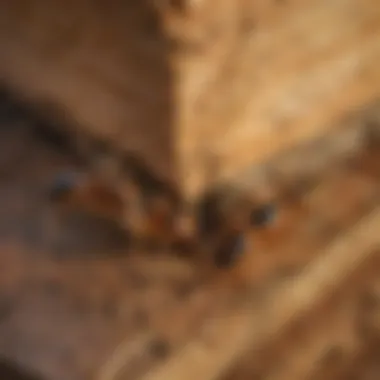

Fumigation is a comprehensive approach often used for severe infestations. This method involves enclosing the entire structure in a tent-like cover and releasing gas that penetrates all areas, effectively exterminating termites. The primary characteristic of fumigation is its thoroughness; it can eliminate termites in hidden cavities and wooden structures that other methods might miss.
However, fumigation typically requires vacating the premises for several days, which can be a significant drawback for homeowners. Additionally, it generally involves higher costs and safety precautions that must be strictly followed.
Evaluating Exterminators
Choosing the right termite exterminator is essential for effective pest control. Evaluating exterminators helps home and property owners make informed decisions that directly impact the success of treatment plans. Selecting the wrong service may lead to incomplete extermination, continued infestations, or even greater damages. This section highlights key factors to consider when evaluating exterminators, focusing on how to ensure you choose a competent and reliable professional.
Experience and Expertise
The experience of an exterminator plays a crucial role in their ability to effectively handle termite issues. Professionals with years of specialized experience are more likely to have encountered various types of infestations and are equipped with knowledge on the most effective solutions.
When assessing a potential exterminator, consider the following:
- Years in Business: A long-standing company often has more experience in the field.
- Specialization: Exterminators who focus primarily on termite control may have more targeted skills and techniques.
- Training: Validations of professional training and ongoing education also indicate a commitment to staying updated on best practices.
Experience without proper expertise is not sufficient. It’s important to ask about specific treatments they have successfully performed and to see if they can customize their approach based on your unique situation.
Certifications and Licensing
Certifications and licenses are vital to confirm that an exterminator meets industry standards and regulations. Each state may have different requirements for pest control operators, so checking these credentials is necessary.
Some points of reference include:
- State Licenses: Ensure the exterminator holds a valid license issued by your state. This can often be checked through a state’s agricultural department or other regulatory body.
- Certifications from National Organizations: Certifications from associations such as the National Pest Management Association signify that the professional is knowledgeable about pest control laws and practices.
- Insurance: Liability insurance protects you in case of accidents during the treatment process. It indicates that the company is responsible and values customer protection.
All these factors ensure that you are hiring someone who is not only qualified but also obliged to follow the best practices in pest management.
Customer Reviews and References
Lastly, one of the most straightforward yet informative ways to evaluate exterminators is to look at customer reviews and references. Feedback from previous clients gives insight into the overall customer experience, effectiveness of the service, and any potential red flags.
To gather information, you can:
- Search Online Platforms: Websites like Yelp or Angie’s List provide reviews and detailed ratings.
- Social Media: Join local community groups on platforms such as Facebook where residents discuss their experiences with local service providers.
- Request References: Ask the exterminator for a list of past clients whom you can contact. Direct inquiries often yield the most honest opinions.
By focusing on these three areas—experience, credentials, and customer feedback—you can sift through the options and find a termite exterminator that is well-suited for your needs.
"Evaluating exterminators is a vital step. The right choice can save you time, money, and headache."
These key components make it clear how thorough evaluation of potential exterminators significantly diminishes the risk of hiring less competent services—ultimately leading to successful termite management.
Cost Considerations
Determining the costs associated with termite extermination plays a vital role in choosing the right service provider. Understanding how costs are influenced by several factors enables homeowners to budget accordingly while ensuring they select a competent exterminator. This section covers the key aspects that impact extermination costs, giving readers clarity on what to anticipate during the evaluation process.
Factors Affecting Extermination Costs
Extent of Infestation
The extent of infestation is a major determinant when calculating the costs for termite extermination. A light infestation might require minimal intervention, such as focused treatment on specific areas. In contrast, a severe infestation could necessitate comprehensive service that involves multiple treatments or significant structural repairs.
An important characteristic of the extent of infestation is its direct correlation with the overall expense. The more widespread the termites, the higher the cost due to the increased labor and materials required. This concept is beneficial as it allows homeowners to understand that addressing problems early can lead to lower costs. One unique feature is the possibility of tiered pricing based on how extensive the infestation is. A homeowner could save more if they act quickly, as treatment for a minor problem is generally less expensive than for a major one.
Extermination Method
The method chosen for extermination also influences overall costs. Various techniques, such as baiting systems, liquid treatments, or fumigation, each come with their own pricing structures. Baiting systems may be lower in initial costs but might require follow-up treatments, adding to the long-term expense. Conversely, fumigation tends to have a higher upfront cost but can be effective in severe cases, providing lasting results.
A key aspect is that the method impacts not only cost but also the efficiency of the treatment. For instance, liquid treatments can provide immediate results but may need additional applications over time. This article emphasizes understanding these methods to make an informed and financially sound decision when seeking extermination services.
Location of Property
The geographical location of a property significantly impacts extermination costs. Regions with higher populations of termites often have more competitive pricing due to the increased availability of extermination services. In contrast, rural areas might have fewer providers, leading to higher prices because of limited options.
A relevant characterics of this factor is that it also affects the type of treatments available. In urban settings, some advanced treatments may be readily accessible, while homeowners in less populated areas might have fewer choices, influencing the cost. Additionally, transportation costs can factor into the final price, depending on how far the exterminator must travel to reach the property.
Affordable Solutions
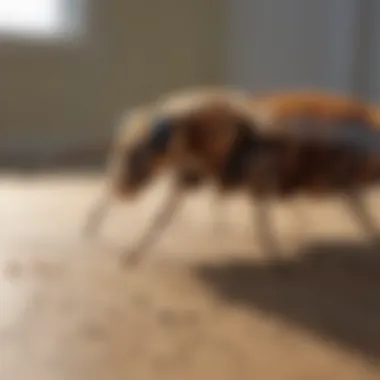

Finding affordable solutions for termite extermination does not have to come at the cost of effectiveness. Homeowners can explore various options, including seeking estimates from multiple exterminators or checking for seasonal promotions. Some pest control companies offer discounts for first-time customers or for bundling services. Reading reviews and seeking recommendations can also guide homeowners toward competent yet budget-friendly extermination services.
Effective communication with potential exterminators about pricing structures, service packages, and possible warranties can lead to better negotiations and prevent unexpected costs down the line. Ultimately, being informed and proactive can ensure comprehensive termite management without overspending.
Eco-Friendly Extermination Options
When dealing with termite infestations, many homeowners prioritize the use of eco-friendly extermination options. This approach is important for several reasons. First, environmentally-conscious individuals prefer treatments that minimize harm to their living space and the surrounding ecosystem. Second, effective eco-friendly practices help ensure the long-term health of the home and its inhabitants while still addressing termite issues. As public awareness of environmental challenges grows, choosing sustainable pest control methods becomes both a responsible choice and a market necessity.
Natural Termite Treatments
Natural termite treatments focus on using substances derived from natural sources to mitigate infestations. These treatments typically do not have the harsh chemicals associated with conventional methods. For instance, some common natural solutions include:
- Orange oil: Derived from orange peels, this oil disrupts the termite's various life stages, making it an effective deterrent.
- Nematodes: Microscopic worms that prey on termites offer an organic solution. Releasing nematodes into infested areas can significantly reduce termite populations without affecting other beneficial organisms.
- Boric acid: While it is a naturally occurring mineral, boric acid is toxic to termites but relatively safe for human use in managed doses.
These methods often require multiple applications and can take time to show results. Homeowners looking for immediate solutions may find themselves frustrated, but patience can lead to sustainable results.
Integrated Pest Management
Integrated Pest Management (IPM) is a comprehensive approach that combines various techniques to manage termite populations effectively while minimizing environmental impact. This method emphasizes prevention and monitoring rather than relying solely on chemical treatments. Key aspects of IPM include:
- Regular inspections: Conducting frequent inspections can help identify potential problem areas before they become significant infestations.
- Habitat modification: Adjustments, such as improving drainage and reducing wood-to-soil contact, can create an inhospitable environment for termites.
- Exclusion techniques: Sealing cracks and gaps in the home's foundation can limit termite entry points.
With IPM, homeowners actively participate in the solution. This approach fosters a long-term relationship with pest management services while demonstrating a commitment to sustainability and a healthier home environment. By choosing IPM methods, homeowners can effectively lower the risks associated with traditional pesticide applications, benefiting both their health and the environment.
"An informed choice in termite management can yield lasting results that safeguard both your home and the ecosystem."
Post-Extermination Measures
After the significant effort of exterminating termites, it is crucial to implement post-extermination measures. These measures are aimed at preventing future infestations and ensuring the integrity of your property. By taking the right steps after treatment, homeowners can effectively safeguard their homes against these destructive pests, minimizing the risk of recurrence. Thus, understanding and applying these measures can greatly contribute to long-term pest management and property maintenance.
Preventive Strategies
Implementing preventive strategies is essential in maintaining a termite-free environment. This section dives into two vital practices: Home Maintenance Tips and Regular Inspections, both of which are instrumental in ensuring the longevity of pest control efforts.
Home Maintenance Tips
Keeping a well-maintained home is a primary step in termite prevention. Proper home maintenance involves several practical steps. For instance, ensure proper drainage around the home and avoid direct wood-to-soil contact. This practice reduces the likelihood of termites accessing wooden structures. A key characteristic of these tips is that they focus on maintaining the overall health of the property. It is a beneficial choice for homeowner because small changes can yield significant results.
Some unique features of home maintenance tips include:
- Eliminating leaks: Moist environments attract termites, and fixing leaks can mitigate this risk.
- Clearing debris: Remove wood piles and debris from around the property to decrease hiding spots for termites.
- Regular upkeep: Routine maintenance not only prevents termite issues but also enhances overall home value.
The primary advantage of these tips is that they are cost-effective measures that help maintain a durable residential structure. However, they also require commitment and awareness from homeowners.
Regular Inspections
Performing regular inspections is another effective preventive strategy. This aspect involves scheduled assessments of the property by pest control professionals or diligent homeowners. Regular inspections help in identifying early signs of termite activity, thus allowing for prompt action. A key characteristic of this practice is its proactive nature, helping to catch potential issues before they escalate.
Benefits of regular inspections include:
- Early detection: Catching termites early can save on costly repairs.
- Peace of mind: Knowing that inspections are regularly done can provide reassurance to homeowners.
- Professional insight: Experts can offer advice on maintaining a termite-free home during inspections.
A unique feature of these inspections is that they can be tailored based on the home's unique characteristics and environment, allowing for a customized approach to pest monitoring. The only downside might be the ongoing cost associated with hiring professionals, but it often outweighs the potential financial losses from a termite infestation.
"Investing in proactive measures like home maintenance tips and regular inspections is essential for long-term peace of mind against termites."
In summary, post-extermination measures are crucial in the fight against termites. Preventive strategies, particularly home maintenance and regular inspections, form a strong foundation for protecting your home. These efforts require ongoing attention and commitment from homeowners, ensuring a continued defense against potential infestations.
The End
Choosing the right termite exterminator involves several critical factors. Understanding these elements helps homeowners make informed decisions that protect their properties and investments from damage caused by these persistent pests. The article breaks down the essentials of evaluating pest control services, including experience, certifications, and customer feedback. Each of these factors plays a significant role in ensuring that the exterminator can effectively manage termite infestations.
Importance of Effective Evaluation
The process of hiring an exterminator should not be rushed. Homeowners need to assess potential candidates by checking their credentials and examining past customer reviews. This thorough evaluation helps identify effective termite exterminators who employ safe and reliable methods. As termites can cause severe structural damage, it is crucial to prioritize these assessments to safeguard your home.
Key Benefits to Consider
- Professional Knowledge: Experienced exterminators have a deep understanding of termite behavior and the best practices for eradication.
- Customized Treatment Plans: A good exterminator recognizes that every situation is unique. They provide tailored solutions that address specific infestation levels and types.
- Long-term Prevention: In addition to immediate eradication, effective exterminators often offer ongoing maintenance plans to prevent future infestations.
- Safety Considerations: The right exterminator applies eco-friendly techniques, minimizing the impact on the environment and the safety of household members.
- Cost-effectiveness: Although initial costs may seem high, hiring an expert can ultimately save money by preventing extensive damage requiring costly repairs.
Final Thoughts
Ultimately, taking the time to find a qualified exterminator not only addresses the current issue but also helps protect the home in the long term. Homeowners should never underestimate the importance of due diligence in selecting professionals who are adept at managing termite problems effectively. By following the advice outlined in this article, finding an ideal exterminator in your local area becomes an achievable and informed process.


